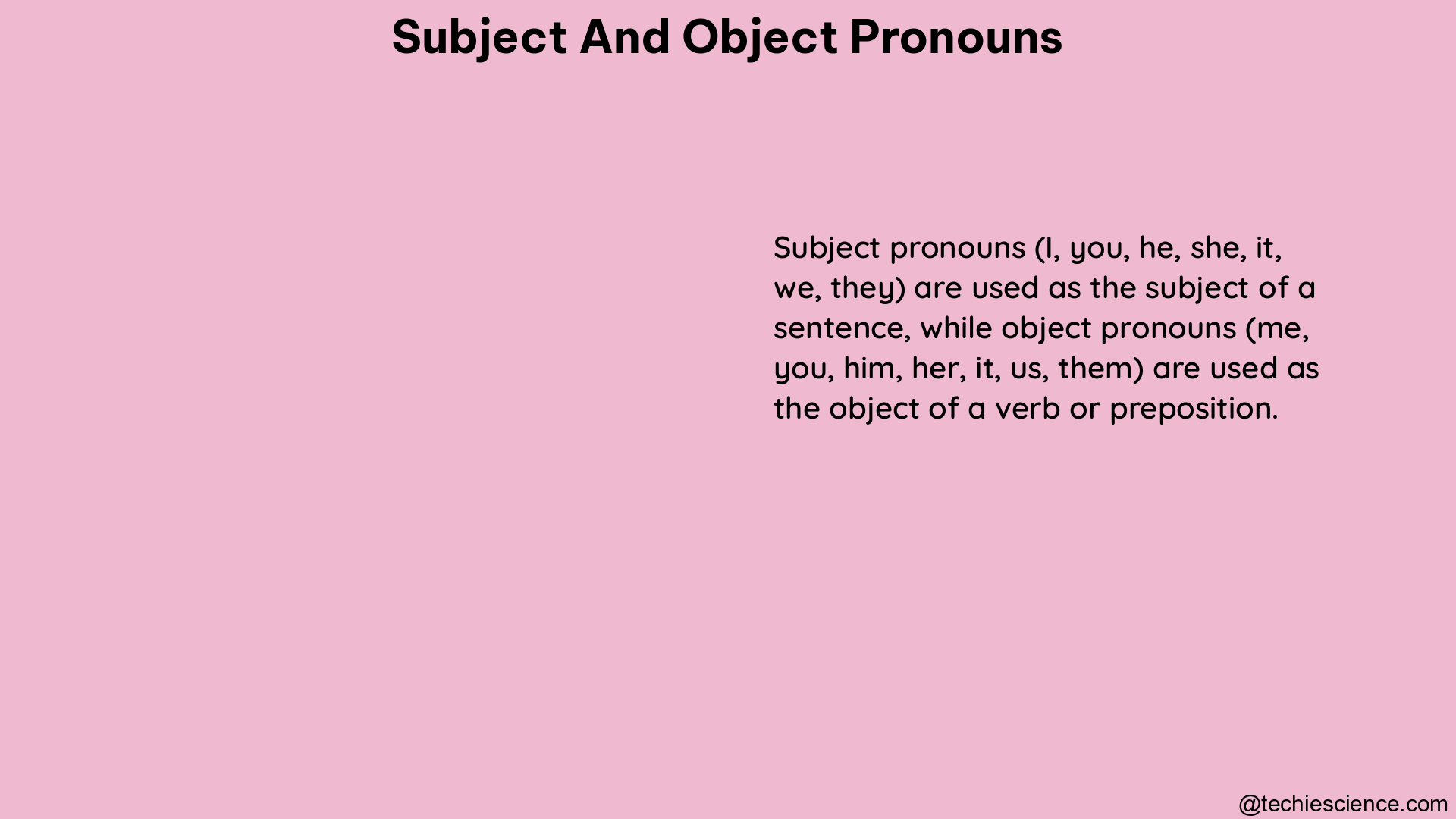Subject and object pronouns are essential components of English grammar, serving distinct functions in sentences. They replace nouns and play a crucial role in sentence structure, ensuring clear and concise communication. This comprehensive guide will delve into the intricacies of subject and object pronouns, providing you with a deep understanding of their usage and mastering their application.
Understanding Subject Pronouns
Subject pronouns are used to replace the subject of a sentence, which is the noun or pronoun performing the action. These pronouns typically come before the verb in a sentence. The subject pronouns in English are:
- I
- You
- He
- She
- It
- We
- They
- Who
Here are some examples of subject pronouns in action:
- I am going to the store.
- She is writing a letter.
- They are playing soccer.
- Who is responsible for this project?
Subject pronouns are essential in maintaining the flow and clarity of a sentence. They help to avoid repetition and ensure that the subject of the sentence is clearly identified.
Exploring Object Pronouns

Object pronouns, on the other hand, replace the object of a sentence, which is the noun or pronoun receiving the action. These pronouns typically come after the verb or preposition in a sentence. The object pronouns in English are:
- Me
- You
- Him
- Her
- It
- Us
- Them
- Whom
Here are some examples of object pronouns in use:
- I gave the book to him.
- She is talking to me.
- They are giving the gift to us.
- Whom did you invite to the party?
Object pronouns are crucial in identifying the recipient of the action in a sentence. They help to avoid ambiguity and ensure that the intended meaning is conveyed clearly.
Key Differences between Subject and Object Pronouns
The primary distinction between subject and object pronouns lies in their function within the sentence:
- Subject pronouns perform the action (they come before the verb).
- Object pronouns receive the action (they come after the verb or preposition).
This difference is essential in maintaining the correct grammatical structure and ensuring that the sentence conveys the intended meaning.
Examples with Proper Nouns
To further illustrate the usage of subject and object pronouns, let’s consider examples that incorporate proper nouns:
- I am talking about the game with Alice. (Proper noun)
- I am talking about the game with her. (Object pronoun)
- Can John, Heather, and I go over to the general store? (Subject pronoun)
- Can we go over to the general store? (Subject pronoun)
In these examples, you can see how subject and object pronouns interact with proper nouns to create clear and coherent sentences.
Tips for Using Subject and Object Pronouns Correctly
To ensure the proper use of subject and object pronouns, consider the following tips:
- Don’t mix cases: Ensure that both pronouns in a sentence are in the same case (subjective or objective).
- Remove one pronoun: Test the sentence by removing one pronoun to determine if it should be a subject or object pronoun.
By following these guidelines, you can develop a strong understanding of when to use subject and object pronouns correctly.
Quiz Examples
Let’s put your knowledge to the test with some quiz examples:
- David loves swimming. In the summer, he goes to the beach every weekend. (Subject pronoun)
- Our uncle always sends us lovely gifts at Christmas. It’s really nice of him. (Object pronouns)
These examples demonstrate the proper usage of subject and object pronouns in different contexts.
Advanced Considerations
As you delve deeper into the world of subject and object pronouns, there are a few additional factors to consider:
- Reflexive Pronouns: Reflexive pronouns, such as “myself,” “yourself,” and “themselves,” are used when the subject and object of a sentence are the same.
- Possessive Pronouns: Possessive pronouns, such as “mine,” “yours,” and “theirs,” indicate ownership or possession.
- Indefinite Pronouns: Indefinite pronouns, such as “someone,” “anyone,” and “nothing,” refer to non-specific entities.
Understanding these advanced pronoun types can further enhance your mastery of English grammar and communication.
Conclusion
Subject and object pronouns are essential building blocks of the English language, enabling clear and concise communication. By understanding the distinct functions of these pronouns and their proper usage, you can elevate your writing and speaking skills, ensuring that your message is conveyed effectively.
Remember, practice makes perfect. Regularly reviewing the concepts covered in this guide and applying them in your daily communication will solidify your understanding of subject and object pronouns, making you a more confident and proficient English language user.
Reference:
- YouTube: Subject and Object Pronouns
- Grammarly: The Basics on Subject and Object Pronouns
- Scribbr: Subject & Object Pronouns

The lambdageeks.com Core SME Team is a group of experienced subject matter experts from diverse scientific and technical fields including Physics, Chemistry, Technology,Electronics & Electrical Engineering, Automotive, Mechanical Engineering. Our team collaborates to create high-quality, well-researched articles on a wide range of science and technology topics for the lambdageeks.com website.
All Our Senior SME are having more than 7 Years of experience in the respective fields . They are either Working Industry Professionals or assocaited With different Universities. Refer Our Authors Page to get to know About our Core SMEs.